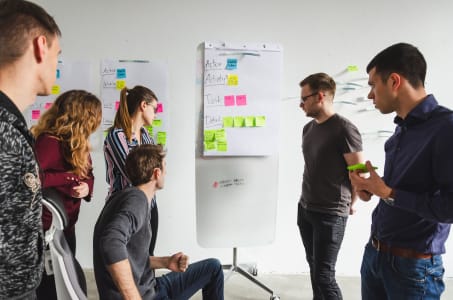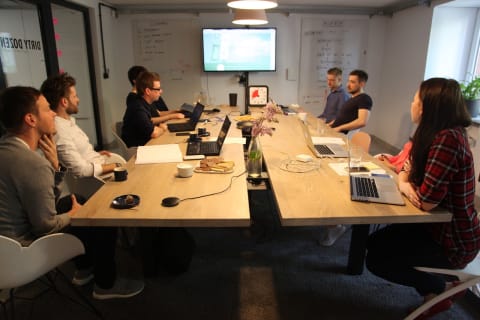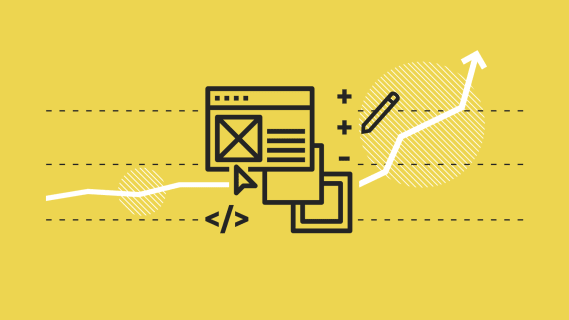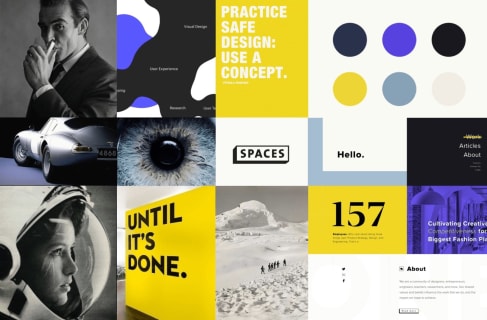How to build psychological safety for more efficient and agile teamwork
If you read this article, you know already that the world has changed. Especially for industries based on providing high quality apps and web products. Without personal communication, distributed teams’ agility and creativity are at risk. If those initial home-office powered productivity peaks decline over the longer term how can we get back to pre-pandemic levels of team performance? For us the solution was improving psychological safety. What is psychological safety and how to create it for your teams? Read on to see four techniques we use to keep our distributed teams in good shape. Then try them out in your organization!

Table of contents
The team. What does it mean?
To ensure that we are on the same page, let’s write down the characteristics of a “team” according to the agile-powered mindset we work in. A team is:
- Small - up to 9 people, to maximize the power of different points of view but minimize time needed for synchronization and information exchange.
- Cross-functional - they have all the necessary skills to achieve the goal.
- Self-organizing - meaning that the team is managed internally, not by a team leader or a project manager outside of the team. Yes! Believe it or not, but here at Boldare, we work without project managers and it’s the “secret sauce” to our efficiency.
- Goal-focused - one specific thing to achieve, helps them to keep focused and organize the work around it.
Leaving aside the basics of recruitment and providing teams with the necessary tools to do the job, let’s focus on the key matter here - why is psychological safety so important?
Psychology safety - the foundation of efficient teams
This is, without a doubt, one of the principles of building effective teams, especially now, when employees are no longer able to discuss their actions or ask advice of their teammates or supervisors in person.
Psychological safety should be felt by all dispersed team members in order to keep the group effective. Why?
According to Google’s re:Work research:
“In a team with high psychological safety, teammates feel safe to take risks around their team members.”
They don’t have to worry that they will be perceived as incompetent or ignorant if the team is going to accept their mistakes, and any eventual mistake won’t be held against them. Psychological safety lies in using failures as lessons to learn and improve from.
Why should you care about creating and maintaining psychological safety in your workplace and teams?
In a team with high levels of psychological safety, members are more eager to make meaningful and effective decisions. And this is extremely important during uncertain and risky times, like the current pandemic. If the team feels safe, they’re not afraid to make bold decisions, and in case of mistakes, they’re not blocked from moving forward and improving their decision-making.
But how to build psychological safety? Here are some of the techniques we use at Boldare to make sure everyone feels safe.
Technique #1: Introduce facilitation to build a sense of meaning
If the whole or majority of the company is working remotely, they’re located in their houses far away from many things that define the company as organization. The office, daily routines and their colleagues are only virtually present, thus it’s easy to question the sense of meaning. If they start asking themselves “What am I even doing here?” it might already be too late to act. What’s the solution?
Good facilitation and the right person in the role of facilitator.
A facilitator is a person who conducts a meeting, takes care of its agenda and executes it and, most importantly, provides direction for the meeting. Briefly, the facilitator is responsible for making the whole work of the team, especially meetings, meaningful.
A facilitator is responsible for building the way the team works:
- how the team solves problems,
- how the team keeps its norms and rules,
- how the team works on the goals they’re committed to.
Usually, in development teams, the facilitator role is held by the scrum master, who takes care of frameworks, roles and rules.
Finally, part of the role of a good facilitator is to reduce the complexity of problems faced by the team. If the team sees the goals clearly, understands the necessary roles and aims, its level of psychological safety is high. As a result, the team sees a way forward clearly.
What do you gain? All team members know that their work has meaning and that they’re still an important part of a vibrant, perfectly working organisation.
Technique #2: Provide a space for everyone to understand each other
Working together but from different places can be tricky.
Especially if the team has to discuss complex issues and make decisions together - and that’s what happens in self-organized teams that are not micromanaged by an omnipotent supervisor. Everyone has to understand each other perfectly, because it supports good decision-making and a sense of belonging. How can we help everyone speak their mind and be understood?
At Boldare, we use ‘question rounds’ as part of meeting agendas:
- Check-in round
- Reaction round
- Check-out round
The Check-in round that occurs at the beginning of a meeting, and is simply a case of asking all the meeting members to state their expectations regarding that meeting. It’s a chance to say how they feel today and which topics they would like to talk about. This way, everyone has a chance to speak their mind and be listened to by others. It also gives a snapshot of the attitude of all meeting members to the agenda topics.
The Reaction round consists of asking all team members to share their opinion on a discussed problem, topic or expressed opinion. It gives a voice to all participants, even those who are usually not so eager to share their thoughts publicly. If someone doesn’t want to share their thoughts, it’s absolutely OK - the reaction round is a tool to let the team members share their opinion and thoughts, not to force anyone to contribute.
The Check-out round is the counterpart to the check-in but conducted at the end of the meeting. It can be used to gather opinions about the meeting outcomes, discussed topics or decisions made by participants. It’s also a chance to summarize the meeting and highlight the outputs or actions to be taken.
Again, this technique provides people with a chance to be heard and involves every member of the meeting. Even for those who usually prefer to follow the meetings silently but have their own thoughts about presented topics. This is absolutely crucial for teams that are not gathered in one space, but dispersed in various locations.
What do you gain? Every team member has their own time and space to share his or her thoughts and discuss key topics. They know that their voice and opinion matter and can influence the way the team works.
Technique #3: Provide a safe space for learning
One thing that COVID-19 brought home is that the world changes quickly and we have to adapt faster than ever. There’s less time for learning in a traditional way by taking courses or by reading books. If you want to learn and take advantage of a new situation, you need to do it on the fly. To make it efficient and meaningful, you need to provide people with the space to learn efficiently.
At Boldare, we use two techniques to provide our employees with safe spaces to learn: retrospectives and feedback workshops.
Retrospectives are part of the scrum methodology and are used by the team to sum up their work (1 or 2-week long sprints usually) and learn what went well and what actions need to be taken to improve in the future. The retrospective length varies depending on the length of the sprint being discussed. One hour of retrospective should be just enough to discuss a sprint of one or two weeks. You can read about this topic in detail in our article: What is a sprint retrospective.
Feedback workshops are half-day workshops in which the team shares feedback about each other’s work. It helps to open up communication between team members in an organized way. After using this technique, we noticed that teams were working with more clarity and less tension between team members.
Want to strengthen your team through a feedback workshop? Get access to the feedback workshops agenda template and other team building assets here.
If you want to try a feedback workshop in your team, you can download the workshop agenda template that we prepared for participants in our Crash Course webinar series. Simply sign up on the course page by clicking this link and get access to all of the webinar series assets.
These workshops help team members to appreciate and provide feedback to all other participants, helping embed the giving of feedback in our daily working lives; there’s no need to wait for the next workshop. The feedback given is usually very detailed and touches on many aspects of everyday work. This builds psychological safety because people feel that there is a proper, dedicated space and time to give and receive feedback. And not only to give feedback but also to receive a lot of appreciation, which in turn builds strong social bonds. After all, it’s also a space where you can personally say “thank you” to those with whom you work the most but never had a chance to do so before.
Feedback workshops are usually held on-site but we have also facilitated them online.
What do you gain? These techniques give you the chance to stop and look back on what has been done and improve further actions. It’s also a chance to appreciate the work of colleagues and get kudos from others.
Technique #4: Team building rituals
Like every tribe, a team must have its own rituals.
In times when we need to keep social distancing and are forced to communicate via various devices, small rituals can help to keep everyone involved. But what are these rituals? Here are examples of some that we are using internally in Boldare across various teams:
- Special “complaining time” at the end of the week - everyone can join an open call and tell everyone what is bothering them at work or in their personal life. The rule is that nobody has to be constructive - everyone can simply say what’s on their mind right now. However, to keep a healthy balance between positivity and negativity we do “appreciation time” meetings as well, where you can share positive things that have occurred during the week.
- Magical question ritual - once a week (usually Monday, to warm up our brains after the weekend) we share a call where a facilitator asks previously prepared questions to all team members. For example, what superpowers would you like to have, or what is the bravest thing you’ve ever done? etc. Answers are usually really surprising!
What’s the purpose of such calls? It’s one answer to our need to share time together and it’s a way to meet and chat, free from work-related topics. And it’s also a complement to new, online forms of spending time together, like online coffees, breakfasts, team lunches, etc.
The importance of team building increases proportionally with the amount of time the team works remotely. The team’s bonds and loyalty to the organization decline with every single new team member who knows only the “remote” side of the company. Ben Waber, the president and co-founder of Humanyze, a MIT-based company, predicts that in time, a company’s culture and creativity will decline in a remote setup. “Within a year or two, overall cohesion of employees, how well they know one another, might suffer,” says Waber.
What do you gain? A team where members know each other, know that they can share their feelings freely, have dedicated time and space to chat with other colleagues and they feel that they belong to a group.
The time is now
Providing psychological safety to your teams can give you an advantage over those of your competitors who are not yet implementing a New Normal strategy or remote-friendly adjustments into their corporate life. While the first effects on productivity of working remotely can be surprisingly positive, in the longer term, the pandemic will disrupt not only development teams, but whole organizations.
The earlier you adjust your organization to the new reality, the earlier you will see results - the time is now!
Share this article:











